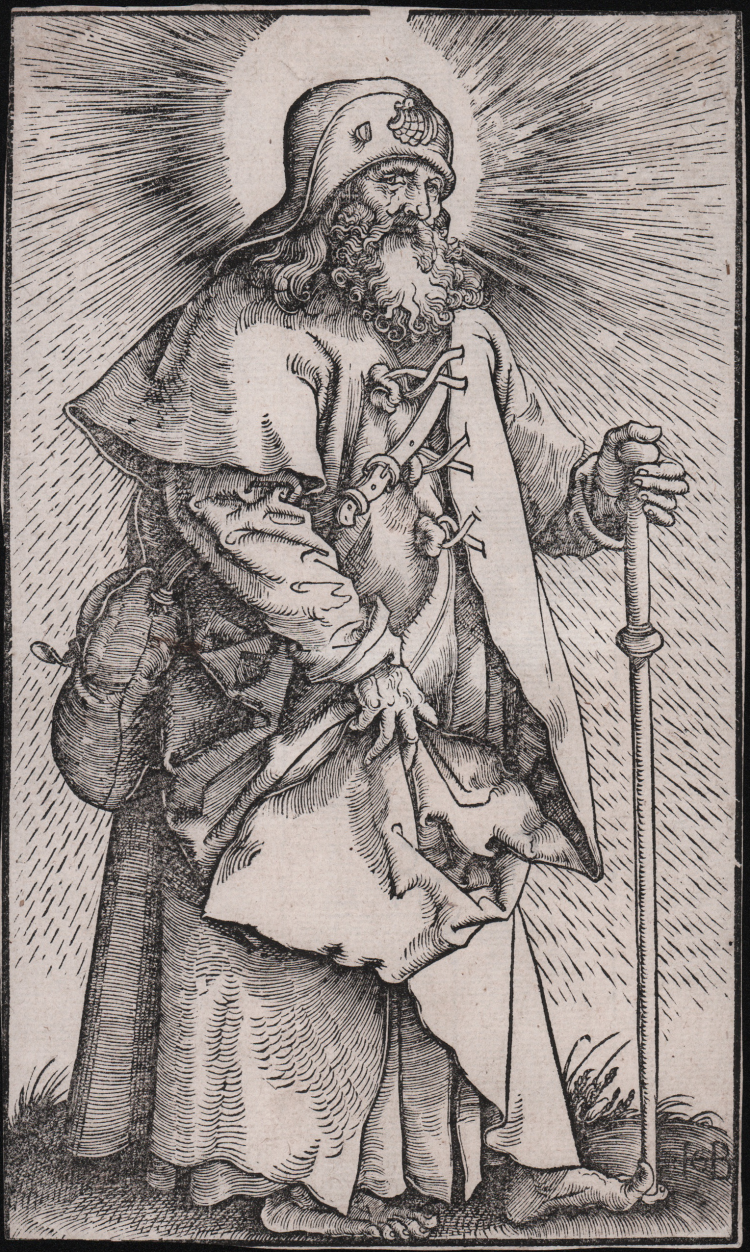- New




| Reference: | A50002 |
| Author | Hans BALDUNG GRIEN |
| Year: | 1519 ca. |
| Measures: | 127 x 215 mm |



| Reference: | A50002 |
| Author | Hans BALDUNG GRIEN |
| Year: | 1519 ca. |
| Measures: | 127 x 215 mm |
St. James the Greater; whole-length figure turned right, with his left foot in front of his right suggesting walking movement. St. James as a bearded figure with a pilgrim's coat and hat, holding a staff in his left hand, blank halo emitting rays across the background.
Woodcut, circa 1519, signed with monogram bottom right.
From the so called the Large Apostle series; the St. Matthew from this series carries the date 1519.
A prominent pupil of the German master Albrecht Dürer, Hans Baldung took the nickname Grien, or Grün for his use of the color green. The artist came from a highly educated family, which set him apart from his German contemporaries. He was well known for his daring choice of grotesque themes, as well as supernatural and erotic subjects. His art included painting, portraiture, wood carving, book illustrations, and stained-glass design. He studied under Dürer, in Nuremberg, from 1503 to 1507 and the two seem to have developed a close friendship, and here he took the nickname Grien, to be distinguished from the other Hans of the studio. Baldung probably moved to Strasbourg and then to Freiburg im Breisgau, where he executed what is known as his masterpiece. Both his paintings and his more famous woodcuts had a very personal style, mainly due to the prevailing influence of the Italian Renaissance. He created many religious, allegorical, mythological works and many depictions of witches. In many cases the artist combined the themes, as in the erotic and the horrific, as in Death and the Maiden or in the depiction of the squire. The artist had a superbly imaginative, sorcery-influenced approach; Baldung also drew wildly erotic scenes, such as The Witch Standing with the Dragon. His approach to portraiture was not dissimilar, as his aim was to capture the personality and mood of his subjects, rather than to make a direct representation.
A fine impression, printed on contemporary laid paper with “small crown” watermark, trimmed to the borderline, very good condition.
Bibliografia
Matthias Mende, 'Hans Baldung Grien. Das graphische Werk', n. 48; Bartsch (VII.308.9); Hollstein, German engravings, etchings and woodcuts c.1400-1700 (82); See K. Parker, 'Early German woodcuts in the BM', MS notes, 2 vols, vol.2, pp.79-80.
Hans BALDUNG GRIEN Strasburgo 1484 circa - 1545
|
German painter, printmaker, draughtsman and stained-glass designer. Such contemporaries as Jean Pélerin (De artificiali perspectiva, 1521) and the Alsatian humanist Beatus Rhenanus in 1526 counted him among the greatest artists of his time. In the opinion of today's specialists, Baldung’s work places him only half a step behind Grünewald, Dürer and Hans Holbein the younger. A prodigious and imaginative artist of great originality, versatility and passion, Baldung was fascinated with witchcraft and superstition and possessed a desire for novelty of subjects and interpretation that sometimes borders on the eccentric. The new themes he introduced include the supernatural and the erotic. He was the first to show the erotic nature of the Fall in his chiaroscuro woodcut of Adam and Eve (1511) and illustrated the successive stages of mating behaviour of horses in his woodcut series of Wild Horses in the forest (1534); and he is remembered especially for his images of witches. Dürer influenced him only in an early stage but not lastingly. Baldung had a very different sensibility and lacked Dürer’s sense of decorum. Grünewald, whose monumental Isenheim Altarpiece (Colmar, Mus. Unterlinden) was created near by during the years Baldung worked in Freiburg im Breisgau, influenced him only temporarily.
|
Hans BALDUNG GRIEN Strasburgo 1484 circa - 1545
|
German painter, printmaker, draughtsman and stained-glass designer. Such contemporaries as Jean Pélerin (De artificiali perspectiva, 1521) and the Alsatian humanist Beatus Rhenanus in 1526 counted him among the greatest artists of his time. In the opinion of today's specialists, Baldung’s work places him only half a step behind Grünewald, Dürer and Hans Holbein the younger. A prodigious and imaginative artist of great originality, versatility and passion, Baldung was fascinated with witchcraft and superstition and possessed a desire for novelty of subjects and interpretation that sometimes borders on the eccentric. The new themes he introduced include the supernatural and the erotic. He was the first to show the erotic nature of the Fall in his chiaroscuro woodcut of Adam and Eve (1511) and illustrated the successive stages of mating behaviour of horses in his woodcut series of Wild Horses in the forest (1534); and he is remembered especially for his images of witches. Dürer influenced him only in an early stage but not lastingly. Baldung had a very different sensibility and lacked Dürer’s sense of decorum. Grünewald, whose monumental Isenheim Altarpiece (Colmar, Mus. Unterlinden) was created near by during the years Baldung worked in Freiburg im Breisgau, influenced him only temporarily.
|